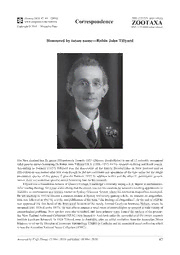
Honoured by taxon name—Robin John Tillyard PDF
Preview Honoured by taxon name—Robin John Tillyard
Zootaxa 2414: 67–68 (2010) ISSN 1175-5326 (print edition) www.mapress.com/zootaxa/ Correspondence ZOOTAXA Copyright © 2010 · Magnolia Press ISSN1175-5334(online edition) Honoured by taxon name—Robin John Tillyard The New Zealand bee fly genus Tillyardomyia Tonnoir, 1927 (Diptera: Bombyliidae) is one of 12 currently recognised valid generic names honouring Dr Robin John Tillyard F.R.S. (1881–1937) for his research on living and fossil insects. According to Tonnoir (1927) Tillyard was the discoverer of the family Bombyliidae in New Zealand and so Tillyardomyia was named after him even though he did not contribute any specimens of the type series for the single uncommon species of this genus, T. gracilis Tonnoir, 1927. In addition to this and the other 11 patronymic generic names, there are numerous specific names honouring him for his research. Tillyard was a Foundation Scholar at Queen’s College, Cambridge University, taking a B.A. degree in mathematics. After reading theology for a year and realising that the church was not his vocation, he secured a teaching appointment in Australia as mathematics and science teacher at Sydney Grammar School, where his interest in dragonflies developed. He left teaching in 1913 to become a research student at Sydney University, gaining a B.Sc. by research on dragonflies. This was followed in 1917 by a D.Sc. and publication of his book “The Biology of Dragonflies”. At the end of 1920 he was appointed the first head of the Biological Section of the newly formed Cawthron Institute, Nelson, where he remained until 1928 (Crosby 1977). He was able to employ a small team of entomologists to research a wide variety of entomological problems. New species were also described, and these primary types formed the nucleus of the present- day New Zealand Arthropod Collection (NZAC) now located in Auckland under the stewardship of the crown research institute Landcare Research. In 1928 Tillyard went to Australia, after an initial invitation from the Australian Prime Minister, to set up the Division of Economic Entomology, CSIRO in Canberra and its associated insect collection which is now the Australian National Insect Collection (ANIC). Accepted by Z.-Q. Zhang: 15 Mar. 2010; published: 30 Mar. 2010 67 When appointed to Nelson, Tillyard saw the need to an entomological library, and through his efforts the Cawthron Institute purchased for £1000 the invaluable library of books, journals, and reprints of Dr David Sharp (1840–1922). Sharp was the Recorder for the “Insecta” section of Zoological Record for volumes 22 (1886) through to 57 (1922) and editor for volumes 28 (1892) to 57 (1922). This library resource is still associated with NZAC. Sharp was pleased his library was going to the new institute: “… our wretched European civilisations are in process of decay, and I hope New Zealand will be a centre for the promotion of a true civilisation …” (letter Sharp to Tillyard 6 April 1921, Ramsay & Crosby 1992). Tillyard’s classic textbook on “The Insects of Australia and New Zealand” was completed at the end of 1924 and published at the end of 1926. This helped to draw the world’s attention to the insects of this region, and gave students and researchers of these countries a much-needed reference source based on groups found in their region. What is not generally realised is that Tillyard was in considerable ill-health as he pushed himself to complete the book. At the end of 1923 he had serious influenza followed almost immediately by pyloric ulcers which kept him bed-ridden until the end of the year. He was then stricken with acute colitis, and by February 1924 was slowly starving to death. He underwent an appendistomy whereby his appendix was used to make an opening for a tube so the diseased colon could be given daily lavations for nine months, and this left him weak and home-bound for all of 1924 (Crosby 1977). His son-in-law J. W. Evans (1947) recorded Tillyard’s love of gardening, and of no garden being complete unless there was a pond “over which his beloved dragonflies could dart and hover.” Tillyard is probably best known outside entomology for his interest in psychical research which he “pursued with the same fearless vigour that he gave to all his undertakings.” Several friends advised him to desist, but in 1928 he published in Nature what he believed was evidence of a survival of a human personality following physical death (Tillyard 1928) and took an active part in séances resulting in the so-called “Walter thumbprints” (De Brath 1931). References Crosby, T.K. (1977) Robin John Tillyard—the man behind the book. New Zealand Entomologist, 6(3), 305–308. [accessible www.bugz.org.nz] De Brath, S. (ed.) (1931) The Margery Mediumship. Solus sittings. Quarterly Transactions of the British College of Psychic Science, 10(2), 88–106. Evans, J.W. (1947) Robin John Tillyard 1881–1937 (Memorial Series, No. 11). Proceedings of the Linnaean Society of New South Wales, 71, 252–256, plate XVII. Ramsay, G.W. & Crosby, T.K. (1992) Bibliography of New Zealand terrestrial invertebrates 1775–1985, and guide to the associated information retrieval database BUGS. Bulletin of the Entomological Society of New Zealand, 11, 1–440 [basis of www.bugz.org.nz] Tillyard, R.J. (1917) The Biology of Dragonflies: (Odonata or Paraneuroptera). University Press, Cambridge, 396 pp. Tillyard, R.J. (1926) The Insects of Australia and New Zealand. Angus & Robertson, Sydney, 560 pp, 44 plates. Tillyard, R.J. (1928) Evidence of survival of a human personality. Nature, London, 122, 243–246. Tonnoir, A.L. (1927) Descriptions of new and remarkable New Zealand Diptera. Records of the Canterbury Museum, 3(2), 101–112. [accessible www.bugz.org.nz] TREVOR K. CROSBY Landcare Research, Private Bag 92170, Auckland 1142, New Zealand [email protected] 68 · Zootaxa 2414 © 2010 Magnolia Press CROSBY
